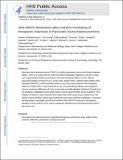DNA–SWCNT Biosensors Allow Real-Time Monitoring of Therapeutic Responses in Pancreatic Ductal Adenocarcinoma
Author(s)
Gong, Xun; Son, Manki; Nguyen, Freddy T.; Strano, Michael S.
DownloadAccepted version (1.276Mb)
Open Access Policy
Open Access Policy
Creative Commons Attribution-Noncommercial-Share Alike
Terms of use
Metadata
Show full item recordAbstract
Pancreatic ductal adenocarcinoma (PDAC) is a highly desmoplastic cancer with limited treatment options. There is an urgent need for tools that monitor therapeutic responses in real time. Drugs such as gemcitabine and irinotecan elicit their therapeutic effect in cancer cells by producing hydrogen peroxide (H2O2). In this study, specific DNA-wrapped single-walled carbon nanotubes (SWCNT), which precisely monitor H2O2, were used to determine the therapeutic response of PDAC cells in vitro and tumors in vivo. Drug therapeutic efficacy was evaluated in vitro by monitoring H2O2 differences in situ using reversible alteration of Raman G-bands from the nanotubes. Implantation of the DNA-SWCNT probe inside the PDAC tumor resulted in approximately 50% reduction of Raman G-band intensity when treated with gemcitabine versus the pretreated tumor; the Raman G-band intensity reversed to its pretreatment level upon treatment withdrawal. In summary, using highly specific and sensitive DNA-SWCNT nanosensors, which can determine dynamic alteration of hydrogen peroxide in tumor, can evaluate the effectiveness of chemotherapeutics.
Date issued
2019-09Department
Massachusetts Institute of Technology. Department of Chemical EngineeringJournal
Cancer research
Publisher
American Association for Cancer Research (AACR)
Citation
Bhattacharya, Santanu et al. “DNA–SWCNT Biosensors Allow Real-Time Monitoring of Therapeutic Responses in Pancreatic Ductal Adenocarcinoma.” Cancer research 79 (2019): 4515-4523 © 2019 The Author(s)
Version: Author's final manuscript
ISSN
0008-5472